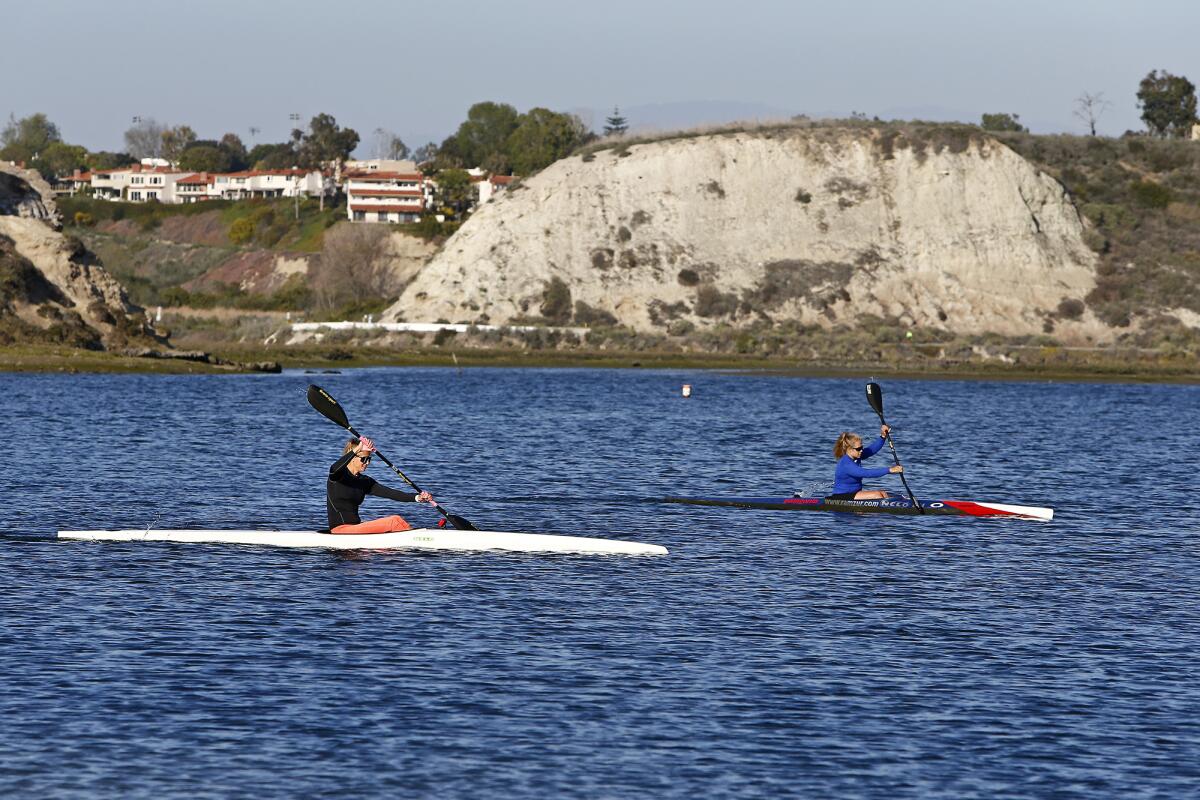Dredging project in Newport Harbor heads to state and federal agencies

Newport Harbor is one of the largest recreational harbors in the country, but natural processes of storm water and erosion flowing in can cause the movement and accumulation of sediment.
That sediment needs to be removed periodically in order to maintain federally authorized channel depths for safe navigation.
To that end, the Newport Beach City Council voted unanimously Tuesday to approve an environmental impact review, placing the matter of constructing a confined aquatic dredged disposal site — a deep hole — in the hands of state and federal agencies.
In response to concerns raised by residents during Tuesday’s public hearing, the council also voted to delegate review of alternative community proposals to a Harbor Commission committee, which will be taking a look and report back to the City Council in 90 days if they believe another option should be considered.
The city was initially looking into the construction of the disposal site back in 2019, when mercury-tainted sediment was found near the turning basin and in the area near Lido Peninsula.
The federal channels in Newport Harbor extend from the entrance channel to the turning basin adjacent to Newport Boulevard bridge. They also extend from the east anchorage between Bay Island and Lido Isle to Marina Park, according to city staff.
Those channels are maintained by the U.S. Army Corps of Engineers, while the rest of the harbor is maintained by Orange County and the city of Newport Beach. The city last undertook a major, but partial dredging project in 2012-13, which removed about 600,000 cubic yards from the channels in the harbor.
The construction of a confined aquatic dredged disposal site, also known as a CAD, would allow for the disposal of the non-ocean quality bottom sediment. The material would be placed into a deep hole and a cap of suitable material would be placed on top of it to create a physical barrier between the material and the ocean.
City staff stressed both in 2019 and in Tuesday night’s presentation that the sediment itself is not toxic by itself. Mercury, however, can accumulate in the food chain and expose humans and other wildlife to more concentrated levels which can then cause neurological impairments, organ damage or other illnesses.
Public works director Dave Webb said that city staff evaluated other potential locations for the construction of the confined aquatic dredged disposal site in Newport Harbor, including in spots adjacent to the north and south sides of Lido Isle and the turning basin.
The decision came down to the central portion of lower Newport Harbor and between Bay Island, Harbor Island and Lido Isle.
Public works administrative manager Chris Miller said the location is in equal proximity to unsuitable material, which means reduced transit time, disruption and costs. It also is deeper — currently about 12 feet in depth, but authorized to go to about 15 feet — which maximizes scow capacities. Also, federally protected eelgrass is not found in that area.
“The other [locations] have issues about loading, extending time. You look at the one right off of Lido Isle and it’s right in the middle of a mooring field in 10 feet of water,” Webb said. “So, not only do we have the scow problems, we can’t load it to get all the way in there.”
The proposed project could hold up to 156,900 cubic yards of material, with about 106,900 cubic yards to be from the federal channel dredging project and an additional 50,000 cubic yards from city channels. No external material outside of Newport Harbor will be placed inside of the confined aquatic dredged disposal site.
Material dug from the hole will be used to renourish Newport’s ocean beaches or at a federally controlled open ocean disposal site.
The total cost of the project is expected to reach $20 million.
Mayor Pro Tem Kevin Muldoon raised concerns as to whether or not any potential disruptions near the disposal site — be it by the tides or passing ships — could potentially cause physical harm to the average person who may be using the waters.
Miller replied that the mercury-tainted sediment would be placed at too significant a depth for it to be picked back up into the water column. He also said the biological tests done on marine life passed toxicity tests.
“I’m not really sure why we wouldn’t do this. I think this seems like something we’ve already run through the regulatory boards,” said Councilman Noah Blom, adding that he felt there’s been an almost excessive amount of due diligence on the project.
“I understand the concerns of the residents. They’re nervous about what’s in the harbor, but it’s already in the harbor. We’re not taking anything and putting it into the harbor. This is already sitting there, maybe on the top level at this point,” said Blom.
“This just seems like a solution rather than a debate,” he added.
All the latest on Orange County from Orange County.
Get our free TimesOC newsletter.
You may occasionally receive promotional content from the Daily Pilot.




